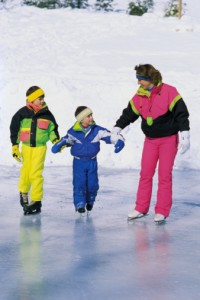Ice Skating: Tips to Stay Safe and Have Fun

- Don’t skate on a pond or lake unless you’re absolutely certain that the ice is thick enough! It needs to be at least four inches thick in order to be safe to skate on. Also, there should be no logs or rocks protruding nearby, as these can impact the thickness of the nearby ice. If the ice is light gray, white, black or looks mottled or slushy, then stay off of it. Thick ice is usually clear or blue. The best thing to do, if you want to skate outdoors, is to stick to places that are monitored in some way, such as state parks or recreational facilities which include ice skating. Choosing a random pond could be recipe for disaster.
- Have the kids wear floatation devices if ice-skating outdoors. If they were to fall through the ice, that would at least keep them afloat. Also, have an ice pick or some other way of breaking ice available, should the unthinkable happen and a child gets trapped under ice after a fall.
- Make everyone wear a helmet. This goes for any type of ice skating, and for roller skating, too! A fall on ice can lead to a nasty bump on the back of the head. Their bicycle helmets will do just fine; make sure they’re strapped on securely. You can also usually rent hockey helmets if you are going to an ice rink. Inexperienced skaters might also wear knee, elbow and wrist pads to help prevent against injury.
- Make sure that your children know not to touch the blades of the skates. They are very sharp!
- Be sure that the skates fit properly. Skates that are too tight will rub and be uncomfortable in a matter of minutes, and skates that are too big will make falls and twisted ankles much more likely.
- Pair your brand new skater with an adult or an experienced older child or teen. The more experienced skater can help the little one to avoid banging into others, and can help steady him if he starts to lose his balance. Encourage them to take it slowly!
- Be on the lookout for signs that your child is getting too cold. She should be dressed in layers and should have on gloves and a hat in order to stay warm enough. Of course, overheating is also a possibility; if your child is getting sweaty, have her remove a layer.
When you’re done ice skating, go in and warm up with some hot chocolate in order to savor a wonderful winter day.
Do you take your kids ice skating? Where do you like to go?